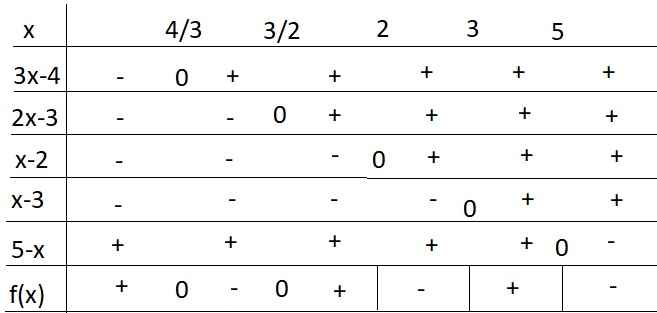giải bất phương trình (x-6)(2x+4)=0

Những câu hỏi liên quan
Câu 1:Tìm nghiệm của bất phương trình x²-5x-6-6|x+1|≤0
Câu 2: Giải bất phương trình|x²-3|+2x≥0
Xem chi tiết
giải bất phương trình sau f(x)=(3x-4)(2x-3)/(x2-5x+6)(5-x)>0
\(f\left(x\right)=\dfrac{\left(3x-4\right)\left(2x-3\right)}{\left(x^2-5x+6\right)\left(5-x\right)}>0\)
\(\Leftrightarrow\dfrac{\left(3x-4\right)\left(2x-3\right)}{\left(x-2\right)\left(x-3\right)\left(5-x\right)}>0\)
Bảng xét dấu:

Từ bảng xét dấu ta thấy nghiệm của BPT là: \(\left[{}\begin{matrix}x< 5\\\dfrac{3}{2}< x< 2\\3< x< 5\end{matrix}\right.\)
Đúng 0
Bình luận (0)
Bàil: Giải phương trình sau a) 2x - 3 3 - x b) 7x - 4 3x + 12 c) 3x - 6 + x 9 - x d) 10x - 12 - 3x 6 + x Bài 2: Giải bất phương trình sau và biểu diễn tập nghiệm trên trục số: a) 4x + 6 2x - 2 b) 3x + 15 0 c) 3x - 3 x + 5 d) x - 4 - 2x + 5 Bài3: a) Một người đi xe máy từ 4 đến B với vận tốc 25km/h. Lúc về người đó đi với vận tốc 30km/h, nên thời gian về ít hơn thời gian đi là 20 phút. Tính AB ? b) Một người đi xe đạp từ A đến B với vận tốc 15 km/h. Sau đó quay về từ B về A với vận tốc 12...
Đọc tiếp
Bàil: Giải phương trình sau a) 2x - 3 = 3 - x b) 7x - 4 = 3x + 12 c) 3x - 6 + x = 9 - x d) 10x - 12 - 3x = 6 + x Bài 2: Giải bất phương trình sau và biểu diễn tập nghiệm trên trục số: a) 4x + 6 <= 2x - 2 b) 3x + 15 < 0 c) 3x - 3 > x + 5 d) x - 4 > - 2x + 5 Bài3: a) Một người đi xe máy từ 4 đến B với vận tốc 25km/h. Lúc về người đó đi với vận tốc 30km/h, nên thời gian về ít hơn thời gian đi là 20 phút. Tính AB ? b) Một người đi xe đạp từ A đến B với vận tốc 15 km/h. Sau đó quay về từ B về A với vận tốc 12 km/h. Cả đi lẫn về hết 4 giờ 30 phút. Tính quãng đường 4B Bài 4: Cho tam giác ABC vuông tại A với AB = 3cm AC= 4cm vẽ đường cao AE. a) Chứng minh rằng AABC đồng dạng với AEBA. b) Tia phân giác của góc ABC cắt AC tại F. Tính BF Bài 5: Cho tam giác ABC có AC = 8cm, AC = 16cm Gọi D và E là hai điểm lần lượt trên cạnh AB và AC sao cho BD = 2cm CE = 13cm Chứng minh rằng a. AAEB AADC b. AED= ABC, cho DE = 5cm Tính BC? C. AE AC AD AB
1:
a: =>3x=6
=>x=2
b: =>4x=16
=>x=4
c: =>4x-6=9-x
=>5x=15
=>x=3
d: =>7x-12=x+6
=>6x=18
=>x=3
2:
a: =>2x<=-8
=>x<=-4
b: =>x+5<0
=>x<-5
c: =>2x>8
=>x>4
Đúng 0
Bình luận (0)
giải bất phương trình (x-1)x(3-2x)/2x-4 > 0
\(y=\dfrac{\left(x-1\right)\left(3-2x\right)}{2x-4}>0\)
nghiệm của y: x - 1 = 0 <=> x = 1
3 - 2x = 0 <=> x = 3/2
y không xác định: 2x - 4 = 0 <=> x = 2
| x | -∞ 1 3/2 2 +∞ |
| x - 1 | - 0 + | + | + |
| 3 - 2x | - | - 0 + | + |
| 2x - 4 | - | - | - 0 + |
| dấu y | - 0 + 0 - || + |
vậy: \(S=\left(1;\dfrac{3}{2}\right)\cup\left(2;+\text{∞}\right)\)
Đúng 0
Bình luận (0)
Trong các bất phương trình sau, bất phương trình nào là bất phương trình bậc nhất một ẩn? A.2x-y<0 B.0x+5≥4 C.x^2-3x+2>x^2-6 D.3/x-4≤0
Giải phương trình và bất phương trình
a) \(3\sqrt{-x^2+x+6}+2\left(2x-1\right)>0\)
b)\(\sqrt{2x^2+8x+5}+\sqrt{2x^2-4x+5}=6\sqrt{x}\)
a.
\(3\sqrt{-x^2+x+6}\ge2\left(1-2x\right)\)
\(\Leftrightarrow\left[{}\begin{matrix}\left\{{}\begin{matrix}-x^2+x+6\ge0\\1-2x< 0\end{matrix}\right.\\\left\{{}\begin{matrix}1-2x\ge0\\9\left(-x^2+x+6\right)\ge4\left(1-2x\right)^2\end{matrix}\right.\end{matrix}\right.\)
\(\Leftrightarrow\left[{}\begin{matrix}\left\{{}\begin{matrix}-2\le x\le3\\x>\dfrac{1}{2}\end{matrix}\right.\\\left\{{}\begin{matrix}x\le\dfrac{1}{2}\\25\left(x^2-x-2\right)\le0\end{matrix}\right.\end{matrix}\right.\)
\(\Leftrightarrow\left[{}\begin{matrix}\dfrac{1}{2}< x\le3\\\left\{{}\begin{matrix}x\le\dfrac{1}{2}\\-1\le x\le2\end{matrix}\right.\end{matrix}\right.\)
\(\Rightarrow-1\le x\le3\)
Đúng 0
Bình luận (0)
b.
ĐKXĐ: \(x\ge0\)
\(\Leftrightarrow\sqrt{2x^2+8x+5}-4\sqrt{x}+\sqrt{2x^2-4x+5}-2\sqrt{x}=0\)
\(\Leftrightarrow\dfrac{2x^2+8x+5-16x}{\sqrt{2x^2+8x+5}+4\sqrt{x}}+\dfrac{2x^2-4x+5-4x}{\sqrt{2x^2-4x+5}+2\sqrt{x}}=0\)
\(\Leftrightarrow\dfrac{2x^2-8x+5}{\sqrt{2x^2+8x+5}+4\sqrt{x}}+\dfrac{2x^2-8x+5}{\sqrt{2x^2-4x+5}+2\sqrt{x}}=0\)
\(\Leftrightarrow\left(2x^2-8x+5\right)\left(\dfrac{1}{\sqrt{2x^2+8x+5}+4\sqrt{x}}+\dfrac{1}{\sqrt{2x^2-4x+5}+2\sqrt{x}}\right)=0\)
\(\Leftrightarrow2x^2-8x+5=0\)
\(\Leftrightarrow x=\dfrac{4\pm\sqrt{6}}{2}\)
Đúng 0
Bình luận (0)
Câu b còn 1 cách giải nữa:
Với \(x=0\) không phải nghiệm
Với \(x>0\) , chia 2 vế cho \(\sqrt{x}\) ta được:
\(\sqrt{2x+8+\dfrac{5}{x}}+\sqrt{2x-4+\dfrac{5}{x}}=6\)
Đặt \(\sqrt{2x-4+\dfrac{5}{x}}=t>0\Leftrightarrow2x+8+\dfrac{5}{x}=t^2+12\)
Phương trình trở thành:
\(\sqrt{t^2+12}+t=6\)
\(\Leftrightarrow\sqrt{t^2+12}=6-t\)
\(\Leftrightarrow\left\{{}\begin{matrix}6-t\ge0\\t^2+12=\left(6-t\right)^2\end{matrix}\right.\)
\(\Leftrightarrow\left\{{}\begin{matrix}t\le6\\12t=24\end{matrix}\right.\)
\(\Rightarrow t=2\)
\(\Rightarrow\sqrt{2x-4+\dfrac{5}{x}}=2\)
\(\Leftrightarrow2x-4+\dfrac{5}{x}=4\)
\(\Rightarrow2x^2-8x+5=0\)
\(\Leftrightarrow...\)
Đúng 0
Bình luận (0)
Giải các phương trình, bất phương trình sau:
1) \(\sqrt{3x+7}-5< 0\)
2) \(\sqrt{-2x-1}-3>0\)
3) \(\dfrac{\sqrt{3x-2}}{6}-3=0\)
4) \(-5\sqrt{-x-2}-1< 0\)
5) \(-\dfrac{2}{3}\sqrt{-3-x}-3>0\)
1) \(\sqrt[]{3x+7}-5< 0\)
\(\Leftrightarrow\sqrt[]{3x+7}< 5\)
\(\Leftrightarrow3x+7\ge0\cap3x+7< 25\)
\(\Leftrightarrow x\ge-\dfrac{7}{3}\cap x< 6\)
\(\Leftrightarrow-\dfrac{7}{3}\le x< 6\)
Đúng 0
Bình luận (0)
Giải bất phương trình sau và biểu diễn tập nghiệm trên trục số: a) 4x + 6 2x - 2 b) 3x + 15 0 c) 3x - 3 x + 5 d) x - 4 - 2x + 5
Đọc tiếp
Giải bất phương trình sau và biểu diễn tập nghiệm trên trục số:
a) 4x + 6 <= 2x - 2
b) 3x + 15 < 0
c) 3x - 3 > x + 5
d) x - 4 >= - 2x + 5
a: =>2x<=-8
=>x<=-4
b: =>x+5<0
=>x<-5
c: =>2x>8
=>x>4
d: =>3x>=9
=>x>=3
Đúng 0
Bình luận (0)
Giải phương trìnhsau x/2x-6-x/2x+2=2x/(x+1)(x-3) Giải bất phương trình sau 12x+1/12_< 9x+1/3 - 8x+1/4
\(\dfrac{x}{2x-6}-\dfrac{x}{2x+2}=\dfrac{2x}{\left(x+1\right)\left(x-3\right)}\left(ĐKXĐ:x\ne-1,x\ne3\right)\)
\(\Leftrightarrow\dfrac{x}{2\left(x-3\right)}-\dfrac{x}{2\left(x+1\right)}=\dfrac{2x}{\left(x+1\right)\left(x-3\right)}\)
\(\Leftrightarrow\dfrac{x\left(x+1\right)}{2\left(x+1\right)\left(x-3\right)}-\dfrac{x\left(x-3\right)}{2\left(x+1\right)\left(x-3\right)}=\dfrac{2x\cdot2}{2\left(x+1\right)\left(x-3\right)}\)
\(\Rightarrow x\left(x+1\right)-x\left(x-3\right)=4x\)
\(\Leftrightarrow x^2+x-x^2+3x=4x\)
\(\Leftrightarrow x^2+x-x^2+3x-4x=0\)
\(\Leftrightarrow0x=0\)
Phương trình có vô số nghiệm , trừ x = -1,x = 3
Vậy ...
\(\dfrac{12x+1}{12}< \dfrac{9x+1}{3}-\dfrac{8x+1}{4}\)
\(\Leftrightarrow12\cdot\dfrac{12x+1}{12}< 12\cdot\dfrac{9x+1}{3}-12\cdot\dfrac{8x+1}{4}\)
\(\Leftrightarrow12x+1< 4\left(9x+1\right)-3\left(8x+1\right)\)
\(\Leftrightarrow12x+1< 36x+4-24x-3\)
\(\Leftrightarrow12x+1< 12x+1\)
\(\Leftrightarrow12x-12x< 1-1\)
\(\Leftrightarrow0x< 0\)
Vậy S = {x | x \(\in R\)}
Đúng 2
Bình luận (0)


















